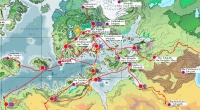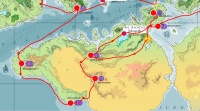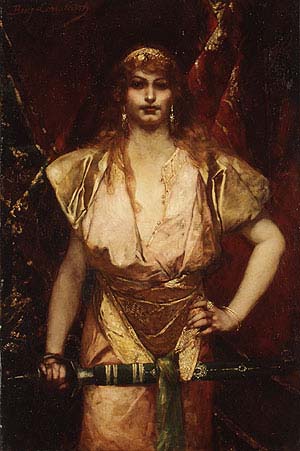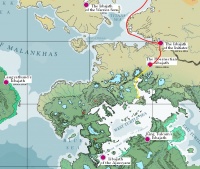Difference between revisions of "The Isbajutha"
Trismegistus (talk | contribs) m (→Sources) |
Trismegistus (talk | contribs) |
||
| Line 344: | Line 344: | ||
*[[Tales of Old Pytharny]], 2555, [[Aliskémon Tharstros]] | *[[Tales of Old Pytharny]], 2555, [[Aliskémon Tharstros]] | ||
| + | |||
| + | ;''[[Fifth Isbajath]]'' | ||
| + | *[[Children of Miyanikhiya]], 2614, Children of the Incarnandina and their roles in the Psychic Crusades, especially Fifth Psychic Crusade, [[Throvian Language]] | ||
| + | *[[Five Lives of the Princes of Chaos]], 2579,[[Amric Ethuve]], biography of five chaos rulers, including Prince Ulcanov | ||
| + | *[[God's Whirlwind: The Isbajutha]], 2568, [[Thulinantis Tepriax of Zamaclë]], [[Ithatian Language]], outlines and highlights the chief events of the Isbajutha (2423 to 2476) and discusses the swiftness and far-reaching consequences | ||
| + | *[[Legend of Saint Gidhoniel]], 2400s, a chanson in [[Khahonri Language]] about Saint [[Gidhoniel kab S'ephah]] in the Fifth Isbajath | ||
| + | *[[Our Heritage of Incarnandist Saints]], 2619, [[Rhionantis the Younger of Aurice]], lists numerous Incarnandist Saints through the centuries with emphasis on Throvian Saints like St. Olmima Olima of the Glade; [[Throvian Language]] | ||
;''[[Seventh Isbajath]]'' | ;''[[Seventh Isbajath]]'' | ||
Revision as of 04:54, 30 October 2014


Also known as the Psychic Crusades, the Isbajutha (plural, from Khahonri s'ebejeh, to fight against with intention; singular isbajath), are the series of calculated wars that brought to an end the dominions of the great Chaos Rulers of the Middle Ages. The Isbajutha consist of the general psychic crusades demanded by the then-ruling Incarnandina, Miyanikhiya kath Agiya, and the lesser psychic crusades, each general Isbajath (psychic crusade) being designated with a number and each lesser isbajath designated with a non-numeric name.
Numerous other conflicts arose during the Isbajutha as the worship of chaos and the practice of chaos magic had become firmly entrenched throughout the Pallathantic Region. The Shenimite Incarnandists, their converts, and their allies in the Arathracian Church followed an organized program aimed at eliminating the chaos leaders with immense success.
The extirpation and exile of the most egregious leaders of the chaos movement fell even more swiftly on the Pallathantic than the speed with which chaos cults arose and flourished in the Middle Ages. Practitioners, priests, and cultist of chaos not slain or converted through the Isbajutha fled into hiding, sometimes with great irony, concealing themselves and their works in the very places of refuge where they had driven Incarnandists and others during the former rule of the princes of chaos.
General Isbajath
Only the acting Incarnandina could invoke the call for a general isbajath. Each such psychic crusade was numbered in chronological order. Incarnandist warriors were spiritually obligated to heed her summons and offer whatever powers that God had granted them in the service of the isbajath. The Incarnandina appointed the generals, often members of her own family, based on the council of retinue who consisted of powerful Incarnandist energists (psychics) often with the abilities of seership in the past, present, and sometimes future. The faithful who fell in the course of an isbajath were thought to enter into the presence of God and become companions of the energy of the Incarnandus. Each general isbajath was also associated with a specific zodiacal sign.
Vowed Isbajath
A vowed isbajath was promised by a powerful Incarnandist warrior or lawful warrior, but was not required by the current Incarnandina. There are numerous such vowed isbajutha and the list below only gives the greater vowed isbajutha which were part of the logistics of the over-all campaign against the Rulers of Chaos. The first of the vowed isbajutha was the Ascetics' Isbajath, vowed by Askymos Reclave.
Commanders
The Incarnandina with the advice of her council, chose the commanders of the isbajath, the route of communications, the proprosed plan of attack, and exigency plans. She designated the harubeel and the th'ughiya of the force. The Incarnandinas of the Isbajutha are Miyanikhiya kath Agiya, Besheth kath Miyanikhiya, She'eseleth kath Besheth, Shadirya kath She'eseleth, and Lushabiya kath Shadirya.
Chronological List of The Isbajutha
Chronology of the Isbajutha
Notes
Copazousa Daughter of Chaos is not listed here as she perished through her own magical experimentation.
Sources
 Primary Sources
Primary Sources
- General
- Oath of the Shenimite Warrior, ca 2240
- Book of Arathracontis
- Funeral Inscription of the Princess Laluthaxa
- Murals of the Tomb of the Family of Kirxionantiaxipos the Scribe
- Oracles of Errenantis
- Princess Sídb Manuscripts, discovered in a neighborhood in Priodezza, Maturn; supposedly copies of letters and diary written by Medibgösk Princess Sídb who was betrothed to Varyaz
- Exhortations of S'ephah kab Shaykhul, Late 23rd century, speeches, advice and wisdom given by S'ephah kab Shaykhul, father of Gidhoniel and husband to Incarnandina Besheth kath Miyanikhiya
- The Glamsagin Chronicle, ca 2290, Ra'esel kab Naphug
- Legend of Saint Gidhoniel, ca 2400s, Gasraf kab Eth'eb
- Teltagurn Fresco, late 23rd century
- Address of Zihera kath Z’alulah to warriors of the Seventh Isbajath, 23rd Century
- Archomagus Codex, 23rd Century
- Asbard Bestiary of Throes
- Asbard Book of Manic Devotions, 20th Century
- Basiliary Codex, very early 24th Century
- Excavation of the Bulamagh Rock Ship
- Funeral Oration of Tirkha kab Ath’on kab Haliyk, ca 2300
- Lygdamioniac Invocation, Late 23rd Century
- Prayers of St. Ithraig dhal Fascaghire, 23rd to 24th century
- Sanctuarial Register of Sruha Leham, 23rd Century
- An Alliance of Two Hearts, 2658, {Asbardian Author}
- Book of the Wars of Arathrax, various years
- Chronicle of the Companions of Jedhur Dragonwilled, ca 2300
- History of Saragean the Stout, 2317, {Erechórebese Author}
- Sanctuarial Register of Errigaidha Nava, various years
- Espruga Letters, ca 2260 to 2270
- Excavation of Harskenassy Hall, excavated 2665
- Glumhearse Terracotta Reliefs, discovered 2584
- Vuheane House Excavations, excavated 2688 to 2695
 Secondary Sources
Secondary Sources
- General and uncategorized
- Alehouse Rumors and the Chant of the Mad Gods, Bírddahab glacha Köín Sträbidwo, 2725, Medibgóëse Language
- Azbulihan's Guide to Djinn of Weshif, Azbulihan ikib Asulimaana, 2421
- Bladewringing Swords of Barystonian Trevirs, Kéwbdraig umba Groichdrubal of Tanthgefri, 2652, Pytharnian Language
- Five Lives of the Princes of Chaos, 2579, Amric Ethuve
- Foundations of the Oliblishi Kingdom, Wanwaya kath Safya, 2527
- From the Fifth Isbajath to the Fifth Geddamin War: The Transformation of Early Modern Aurice, Danax Aistaga, 2702
- Children of Miyanikhiya, 2614, Children of the Incarnandina and their roles in the Psychic Crusades, especially Fifth Psychic Crusade, Throvian Language
- Five Lives of the Princes of Chaos, 2579,Amric Ethuve, biography of five chaos rulers, including Prince Ulcanov
- God's Whirlwind: The Isbajutha, 2568, Thulinantis Tepriax of Zamaclë, Ithatian Language, outlines and highlights the chief events of the Isbajutha (2423 to 2476) and discusses the swiftness and far-reaching consequences
- Legend of Saint Gidhoniel, 2400s, a chanson in Khahonri Language about Saint Gidhoniel kab S'ephah in the Fifth Isbajath
- Our Heritage of Incarnandist Saints, 2619, Rhionantis the Younger of Aurice, lists numerous Incarnandist Saints through the centuries with emphasis on Throvian Saints like St. Olmima Olima of the Glade; Throvian Language
- Siege of Bryndyd (Book), Straudh dhal Rhiggoinech Siarbha, 2619
- Sword of the Maiden of Zephas, Irchoram of Asberdon, 2547, Sometimes treated as a primary source
- The Witch and the Tisbajiya: The Second Battle of the Archmage, Aiachourn dhal Caspain Sichogha, 2687
- Incarnandist Siege of Trevirs, Iff dalg Kiabuirre Bangrin, 2592, Pytharnian Language
- Siege and Battles of the Twelfth Isbajath, Airugadin dalg Lioguirne Ucharba, 2518, Pytharnian Language
- Standard-bearers of the Twelfth Isbajath, Ofalde dalge Aodhaiva Dascor, 2682, Pytharnian Language
- Telepathy in the Command Strategy of the Twelfth Isbajath, Iff dalg Kiabuirre Bangrin, 2597, Pytharnian Language
- Terrors of the Changeable Gods, Ofalde dalge Aodhaiva Dascor, 2681, Pytharnian Language
See Also
- Hospice
- List of Greater Chaos Rulers of the Middle Ages
- List of Incarnandinas
- List of Lesser Chaos Rulers of the Middle Ages
- Chronology of the Isbajutha
| This article is a stub. It requires further development by the creator. |

